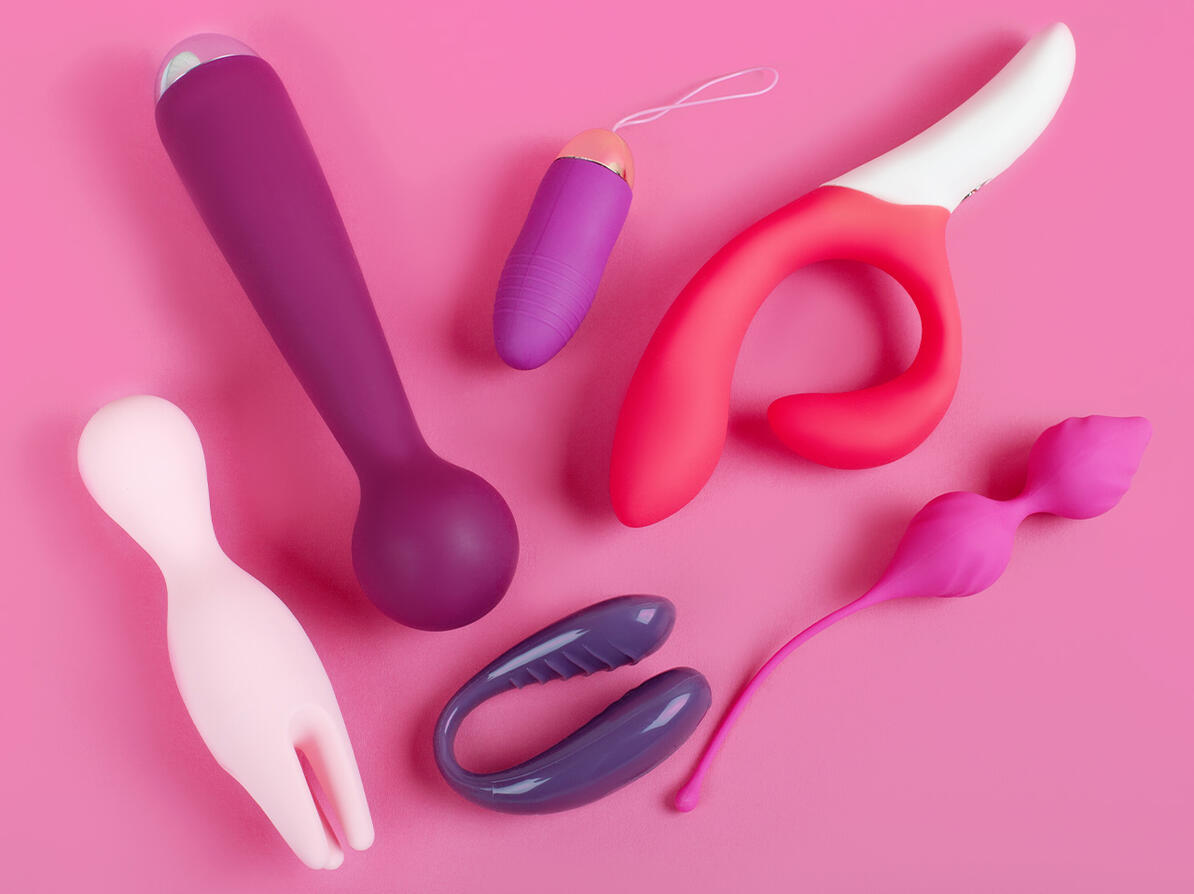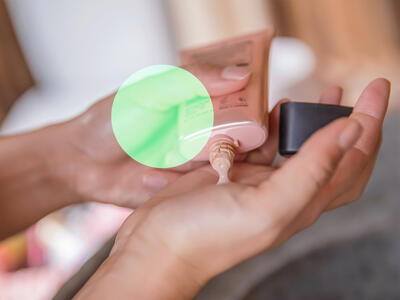Er der uønsket kemi i vibratorer og glidecremer?
Der kan være problematiske kemikalier for miljøet og sundheden i glidecremer og sexlegetøj af silikone. Få styr på, hvilke stoffer du skal undgå her.

I et nyt studie baseret på svar fra 12.000 deltagere fra seks forskellige lande, er det danskerne der ejer mest sexlegetøj. I gennemsnit ejer de adspurgte danskere fem stykker legetøj.
Studiet er udført af Københavns Universitet i samarbejde med Sinful. Deltagerne er fra Danmark, Sverige, Norge, Finland, Frankrig og Storbritannien.
Men har vi styr på, om vores sexlegetøj og glidecremer indeholder uønsket kemi? I 2020 undersøgte Forbrugerrådet Tænk Kemi både glidecremer og vibratorer for uønsket kemi.
Se, hvilke kemikalier vi fandt dengang, og hvordan du kan undgå uønsket kemi i dit sexlegetøj.
Afgivelse af "flygtige stoffer" fra alle vibratorer
En laboratorietest af Forbrugerrådet Tænk Kemi fra 2020 viste, at vibratorer og dildoer af silikone afgiver flygtige forbindelser – som betyder, at sexlegetøjet frigiver kemiske stoffer. Hvilke stoffer der er tale om, viste testen ikke.
”De flygtige stoffer er formentlig ikke problematiske for din sundhed, men afgivelse af kemikalier fra produkter er ikke optimalt, når det er i tæt kontakt med kroppens sårbare områder”, fortæller testansvarlig i Forbrugerrådet Tænk Kemi, Christel Søgaard Kirkeby.
Silikonestoffer i vibratorer
Testen viste også, at vibratorer af silikone indeholdt mindre mængder uønskede siloxaner.
Siloxaner er en stor gruppe af silikonestoffer, hvoraf nogle er på EU’s liste over særligt problematiske stoffer.
”Indholdet af siloxaner i de 9 testede vibratorer var så begrænset, at det ikke i sig selv udgør nogen grund til bekymring. Udsættelse for disse silikonestoffer er større fra fx kosmetik og hudcremer”, siger Christel Søgaard Kirkeby.
De ni testede vibratorer levede eksempelvis ikke op til de tyske anbefalinger, der gælder for silikone, som er beregnet til kontakt med mad og drikke.
Parfumerede vibratorer
Tre ud af ni vibratorer i den tidligere test lugtede tydeligt parfumerede. Det var tre vibratorer fra:
- Lelo
- We-vibe
- Smile Makers
”Det stod ikke på produkterne, at de var parfumerede, og derfor er det godt at bruge lugtesansen. Det er generelt en god ide at skrue ned for parfume i produkter, der er i tæt kontakt med huden”, siger Christel Søgaard Kirkeby.
Testen viste samlet set, at der ikke er grund til bekymring for kemien i silikonevibratorer, men at branchen har mulighed for at arbejde på at mindske frigivelsen af de flygtige stoffer.
Det vigtigste du som forbruger skal tage stilling til, er om produktet er parfumeret. Det skal ikke stå på produktet, så du må spørge eller lugte dig frem.
Gå også efter en producent, som du har tillid til.
Uønsket kemi i glidecremer
Glidecremer kan indeholde meget allergifremkaldende eller mistænkt hormonforstyrrende stoffer.
En deklarationstest fra 2020 af Forbrugerrådet Tænk Kemi viste, at seks ud af 31 glidecremer indeholdt uønsket kemi og fik den dårligste bedømmelse, C-kolben. Testen viste, at:
- To glidecremer indeholdt et mistænkt hormonforstyrrende silikonestof (cyclopentasiloxane) som hovedingrediens. Stoffet er også problematisk for miljøet.
- To glidecremer indeholdt parabener (methylparaben og sodium methylparaben), de er mistænkt for at være hormonforstyrrende.
- To glidecremer indeholdt de meget allergifremkaldende konserveringsmidler MI og MCI (methylisothiazolinone og methylchloroisothiazolinone). Stofferne må ikke længere anvendes i plejeprodukter der bliver på huden.
I testen indeholdt fire glidecremer også parfume eller allergifremkaldende planteekstrakter.
En glidecreme med uønsket kemi udgør sandsynligvis ikke en risiko i sig selv, selvom optaget gennem slimhinden kan være anderledes end gennem huden.
Men glidecremer kan bidrage til din samlede udsættelse for uønskede kemikalier - den såkaldte cocktaileffekt. Den samlede mængde af uønsket kemi kan være problematisk, hvis du udsættes for det fra mange forskellige produkter. Det kan fx være problematisk i forhold til hormonforstyrrende effekter.
Gode råd til sexlegetøj og glidecremer
Undgå parfumeret sexlegetøj
Vibratorer kan være tilsat parfume. Vælg gerne vibratorer uden parfume. Du kan spørge i butikken eller lugte dig frem, når du køber.
Lugter din vibrator kemisk, så lad det gerne afdampe et par uger, inden du tager det i brug. Er det en vedvarende kraftig kemisk lugt, så kontakt producenten og hør, om det kan være meningen.
Tjek glidecremer med Kemiluppen
Der findes 60 glidecremer og intimplejeprodukter i vores gratis app Kemiluppen. Otte glidecremer får den laveste bedømmelse C-kolben pga. indhold af uønskede kemikalier, eksempelvis mistænkt hormonforstyrrende stoffer.
En glidecreme kan også indeholde parfumestoffer, der er i kontakt med følsomme dele af din krop. Tænk derfor over, om det er nødvendigt med parfume eller allergifremkaldende planteekstrakter i din glidecreme.
Se, om din glidecreme er med i appen.
Nogle glidecremer kan skade sexlegetøj og kondomer
Glidecremer kan være vandbaserede, oliebaserede og silikonebaserede. Det er ikke alle slags glidecremer, du kan bruge sammen med sexlegetøj eller kondomer. Silikonebaseret glidecreme skal ikke bruges sammen med sexlegetøj af silikone, da det kan skade silikonen i produktet.
Vandbaseret glidecreme er ofte et godt valg. Husk at følge vejledningen på produkterne.
Sexlegetøj af blød PVC kan indeholde ftalater
Plasttypen PVC kan blødgøres med stofferne ftalater. Flere ftalater er mistænkt for at være hormonforstyrrende.
Køber du sexlegetøj i plastikmaterialet PVC, kan du spørge ind til om det er blødgjort med ftalater. Vær opmærksom på, at blød PVC ikke genanvendes og bliver deponeret.
Overvej gerne produkter i et andet materiale.
Test af vibratorer og glidecreme
-
Forbrugerrådet Tænk Kemi har i foråret 2020 indkøbt vibratorer på danske hjemmesider og sendt dem til laboratorietest. Alle de udvalgte produkter havde silikoneyderside.
Alle vibratorer i testen fik en middel kemibedømmelse, B-kolben
De testede produkter var:
- Belladot Bodil vibrator
- Bswish BDesired Deluxe vibrator
- Fifty Shades of Grey Greedy Girl vibrator
- Fun Factory Jam Slim Vibrator
- Lelo Ella non vibrating Pleasure Object
- Sinful Petite mini magic wand
- Smile Makers The Millionaire vibrator
- Tickler Rebel vibrator
- We-vibe Rave vibrator
Disse stoffer fandt vi:
Siloxaner
Der er testet for indhold af forskellige såkaldte cykliske siloxaner. De fundne niveauer var:
Cyclotetrasiloxane (D4) 31 til 240 milligram per kilo samt en enkelt under detektionsgrænsen.
Cyclopentasiloxane (D5) 180 til 610 milligram per kilo.
Cyclohexasiloxane (D6) 470 til 810 milligram per kilo.
Flygtige forbindelser
De flygte forbindelser er testet på sammen måde som fødevarekontaktematerialer af silikone. Materialet opvarmes, og det vejes før og efter.
Testene viste fordampning på 1,1 til 1,7 procent. Anbefalingen fra BfR for fødevarekontaktmaterialer er under 0,5 procent.
Testen viser ikke, hvilke stoffer der fordamper fra materialet.
Peroxid og PAH
Der blev ikke målt indhold af peroxid og PAH.
Parfume
3 produkter var parfumeret. De havde en tydelig duft af parfume.
Testen viser ikke grund til bekymring. Men Forbrugerrådet Tænk Kemi opfordrer producenterne til at arbejde med at mindske de flygtige stoffer i silikonen samt brugen af siloxanerne.
Det sagde virksomhederne
Belladot:
"Vi tager enhver potentiel menneskelig eller miljømæssig risiko seriøst. Belladots produkter lever op til REACH-lovgivningen, som er den gældende europæiske lovgivning for særligt problematiske kemikalier på EU’s kandidatliste. Vi overholder alle grænser i forhold til den nuværende kandidatliste."
WOW Tech (We-vibe)
"De grænseværdier for flygtige organiske forbindelser, som er sat af BfR (Det tyske risikovurderingsinstitut, red.), er anbefalede grænser for fødevarekontaktmateriale. Selvom vi ikke har fødevarekontaktprodukter, vælger vi silikone til vores legetøj, som er testet og overholder disse høje standarder.
Siloxanerne, som er testet i forhold til REACH-lovgivningen om særligt problematiske kemikalier, overholder lovens grænser og anbefalinger. Derudover arbejder vi kontinuerligt på at forbedre vores materialer og produktion for at sikre, at vores produkter forbliver sikre."
Forbrugerrådet Tænk Kemi-kommentar: I testen overholdt produktet ikke BfR’s grænseværdier for afgivelse af flygtige organiske forbindelser for fødevarekontaktmaterialer.
-
Forbrugerrådet Tænk Kemi har i foråret 2020 købt en lang række glidecremer i danske butikker og webshops.
Herefter har vi lavet en såkaldt deklarationstest af produkterne. Det vil sige, at vi har undersøgt ingredienslisterne på produkterne. Det deklarerede indhold er sammenholdt med en lang række lister over problematiske stoffer, som kan have varige uønskede effekter.
Disse effekter kan for eksempel være allergi eller hormonforstyrrende effekter.
Testen er foretaget på samme måde som Forbrugerrådet Tænk Kemi vurderer kosmetik og plejeprodukter i appen Kemiluppen.
Testen tager ikke højde for, hvilke koncentrationer stofferne findes i. Den tager heller ikke højde for stoffer, der kan give irritation, produkternes pH-værdi eller lignende.
Testen er i juli 2020 suppleret med yderligere 2 glidecremer af mærket Pjur med indhold af det allergifremkaldende stof MI. Forbrugerrådet Tænk Kemi blev gjort opmærksomme på produkterne via appen Kemiluppen.
Produkterne får disse vurderinger i testen:
-
21 produkter er uden en række problematiske kemikalier og får bedste kemibedømmelse (A)
-
4 produkter indeholder parfume/planteekstrakter og får middel kemibedømmelse (B)
-
6 produkter indeholder stoffer, der blandt andet er allergifremkaldende eller mistænkt for at være hormonforstyrrende, og får laveste kemibedømmelse (C)
Disse stoffer fandt vi i testen
Mistænkte hormonforstyrrende stoffer
Stoffet cyclopentasiloxane er mistænkt for at være hormonforstyrrende.
Det er også miljøbelastende, og stoffet kan ophobes i naturen. På grund af miljøbelastningen arbejder EU på at nedsætte den tilladte brug i en række produkter til 0,1 procent. Det gælder blandt mange andre produkter også for glidecreme.r
Parabener i form af methylparaben og sodium methylparaben indgår i 2 produkter. Stofferne er mistænkt for at være hormonforstyrrende.
Det må formodes, at der ikke er en risiko ved at anvende de konkrete produkter i sig selv. Men koncentrationen af cyclopentasiloxane kan være høj i produkterne, og det er muligt, at der er et større optag af stoffet gennem slimhinderne end gennem huden.
Lovgivning
Glidecremer kan høre under forskellige lovgivninger, alt efter hvordan de markedsfører sig.
Hvis de er betegnet som medicinsk udstyr, vil de være mærket med CE-mærkning. Glidecremer kan også være betegnet som kosmetik eller være under betegnelsen kemiske produkter.
Men glidecremer er et gråzoneområde, og det ikke er entydigt, hvilken lovgivning produkterne tilhører.
I testen er der 2 CE-mærkede produkter (medicinsk udstyr), som indeholder de meget allergifremkaldende konserveringsmidler methylisothiazolinone (MI) og methylchlorisothiazolinone (MCI). Disse stoffer er ikke tilladt i kosmetik, der bliver på huden.
Testen viser derudover ikke nogen markant forskel på indholdsstofferne i forhold til, om de er CE-mærkede eller ej.
EU's videnskabelige komité på kosmetik har konkluderet, at der ikke er fundet en sikker koncentration af MI/MCI for kosmetikprodukter, der bliver på huden.
Forbrugerrådet Tænk Kemi mener, at det vil stille forbrugerne bedst, hvis lovgivningen beskytter på tværs af områder og ikke tillader MI/MCI i glidecreme, der er medicinsk udstyr.
Det sagde virksomhederne
Pjur
Om MI-indhold: “Selvom vi ikke er forpligtede til det, fordi vores produkt er et medicinsk produkt, har vi ændret formuleringen og har allerede introduceret nye produkter uden disse konserveringsmidler på markedet”.
Om cyclopentasiloxane-indhold: “EU-kommissionen undersøger og overvejer restriktioner mod cyclopentasiloxane, men har stadig ikke truffet en beslutning. Vi søger dog efter et alternativt råmateriale.”
-

Disse uønskede stoffer er i kosmetik
Omkring hver tredje kosmetiske produkt i appen Kemiluppen indeholder uønsket kemi, der kan give allergi, er miljøbelastende eller mistænkt hormonforstyrrende. Bliv klogere her.

Disse foundations indeholder uønsket kemi
Næsten halvdelen af flydende foundations i vores test indeholder mistænkt hormonforstyrrende stoffer eller særligt miljøbelastende stoffer.

Undgå disse stoffer i barberskum og gel
Næsten hver fjerde barberskum og gel i testen indeholder problematiske kemikalier for miljø og sundhed. Se mere her.